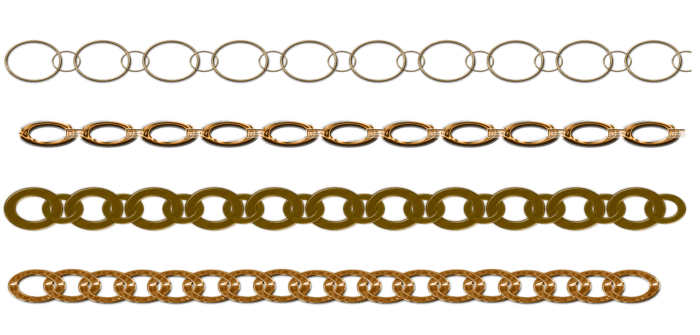The Evolution of Chain Jewelry: From Ancient Times to Modern Fashion Statements
Table of Contents

- Unraveling the Origins of Chain Jewelry
- The Rise of Chain Jewelry in Fashion
- Materials and Craftsmanship in Chain Making
- Choosing the Right Chain for You
- Chain Jewelry in the Digital Age
- Popular Chain Styles and Their Meanings
- How to Incorporate Chain Jewelry in Modern Wardrobes
- Celebrity Influence on Chain Jewelry Popularity
- The Art and Culture of Gifting Chain Jewelry
- The Future of Chain Jewelry: Innovations and Trends
Key Takeaways
- Chain jewelry traces its origins back to ancient times and carries rich historical importance.
- Different materials and designs have shaped the evolution of chain styles over the centuries.
- Choosing the proper chain involves understanding different chain types and how they complement personal style.
- Advancements in technology and changes in cultural perceptions are influencing the future of chain jewelry.
Unraveling the Origins of Chain Jewelry
The story of chain jewelry is as complex as its form’s intricate links. The earliest examples can be traced back thousands of years when they were not merely decorative items but potent symbols of status and power. Ancient Sumerians created chains from gold, which bore significant religious and cultural meaning. Over time, these adornments symbolized wealth and status, as only the affluent could afford such luxuries. Interestingly, chain-making techniques paralleled the rise and fall of civilizations, leaving behind a treasure trove of artifacts that offer a glimpse into the past. As societies evolved, so did the construction and patterns of chains, transforming into the diverse array of designs we recognize today. These beautiful remnants and historical documents convey ancient craftsmanship and aesthetic sensibilities.
The Rise of Chain Jewelry in Fashion
As time marched on, the symbolism and utility of chain jewelry transitioned from the hands of royalty to the necklines of the upper echelons of society during the Middle Ages. However, it wasn’t until the Industrial Revolution that chain jewelry became accessible to the masses, allowing more people to partake in fashion trends formerly reserved for the elite. The 20th century saw chain jewelry cement itself as an essential accessory intertwined with various cultural movements. Rock stars of the ’70s draped themselves in heavy metal chains, while rappers in the ’80s and ’90s elevated the chain to an iconic status symbol, a movement richly documented. Revolving around expression and individuality, chains have continued to reflect societal changes, iterating new designs that resonate with each generation’s sensibilities.
Materials and Craftsmanship in Chain Making
The metals that carry the weight of this jewelry type are as varied as the links themselves. Traditional metals like gold, silver, and platinum are perpetually famous for their luster and durability. However, modern metallurgy has introduced alternative materials, such as stainless steel and titanium, expanding the horizons of design and affordability. Crafting a chain is a testament to human creativity—individual links are meticulously formed and assembled to create a decorative and durable item. Ethical issues such as sustainable mining practices and fair labor conditions are now at the forefront of the chain-making industry. Consumers nowadays appreciate the beauty of their jewelry and the social and environmental implications of their purchases, reflecting a broader awareness of global interconnectedness and responsibility.
Choosing the Right Chain for You
With a bewildering array of options on the market, choosing the proper chain can be a nuanced affair. It is essential to consider aesthetic preferences, practicality, and comfort. A choker-length chain might be perfect for an elegant evening event, while a longer, more robust chain could serve as a daily wear piece. The thickness and strength of a chain are also critical, especially when considering whether to add pendants. Once the perfect chain is selected, it must be cared for properly. Regular polishing, gentle cleaning, and safe storage will help your treasured chains maintain shine and avoid entanglement. Collectors and fashion enthusiasts alike understand that to preserve the beauty of chain jewelry, one must treat it with respect and care.
Chain Jewelry in the Digital Age
Our shopping habits have dramatically shifted with the advent of online retail, and the chain jewelry marketplace is no exception. Numerous online platforms, like chain specialty stores, offer various styles that cater to every conceivable taste and budget. Virtual try-on apps empower consumers to visualize how a piece might look on them before making a purchase. Furthermore, customer reviews and online forums provide valuable insight, helping potential buyers make informed decisions. These digital tools streamline the shopping experience and create a community of jewelry enthusiasts who share recommendations and styling tips.
Popular Chain Styles and Their Meanings
The links of chains can be as symbolic as they are stylish. Take the Cuban link chain, for instance; its bold, interlocking pattern exudes a sense of strength and firmness. In contrast, the daintier Singapore chain reflects delicacy and complexity with its twisted and interwoven links. As society gravitates towards inclusivity, the jewelry industry adapts, offering unisex and gender-neutral options. This evolution is part of a more significant cultural shift towards rejecting rigid gender norms and embracing a spectrum of styles, a sentiment shared by reputable sources. This newfound versatility in chain jewelry allows for a broader expression of identity and personal style.
How to Incorporate Chain Jewelry in Modern Wardrobes
Chain jewelry has stealthily woven its way into the fabric of modern fashion, proving its versatility in various stylistic contexts. Layering multiple chains can create an eclectic and textured look for the fashion-forward. Such combinations break from conventional norms and open a playground for personal expression. Mixing metals once considered a fashion blunder, is now embraced as a cutting-edge trend, further expanding the creative possibilities of wearing chain jewelry. These flexible approaches to fashion allow chains to transcend being mere accessories; they become emblematic of individualism and contemporary style.
Celebrity Influence on Chain Jewelry Popularity
The allure of chain jewelry often skyrockets when a celebrity endorses a particular style or design. These fashion statements can ignite widespread trends, influencing both designers and consumers. When a celebrity debuts an innovative chain design, it can rapidly transition from exclusive luxury to a sought-after commodity in mainstream fashion. The ripple effect of such endorsements is evident in how quickly a chain style becomes pervasive, signifying the potent interplay between celebrity culture and consumer behaviors.
The Art and Culture of Gifting Chain Jewelry
Gifting jewelry, particularly chains, is imbued with emotional richness. A thoughtfully selected chain can become a cherished emblem of a relationship or a significant event. Today’s market offers many personalization options, from engravings to custom link configurations, enabling the giver to impart a unique touch to their present. The chain becomes more than a gift; it transforms into a narrative woven from the threads of personal connection and artistic expression.
The Future of Chain Jewelry: Innovations and Trends
Looking into the crystal ball of fashion, the future of chain jewelry is iridescent with potential. Technological advancements such as laser cutting and 3D printing have revolutionized design processes, allowing for intricate patterns previously unattainable. Furthermore, the increasing drive towards ethical sourcing and sustainability promises a new era of responsible luxury. As consumer tastes evolve and new technologies emerge, we can confidently anticipate that chain jewelry will continue to dazzle and adapt, remaining an enduring testament to our innate desire for adornment and expression.







